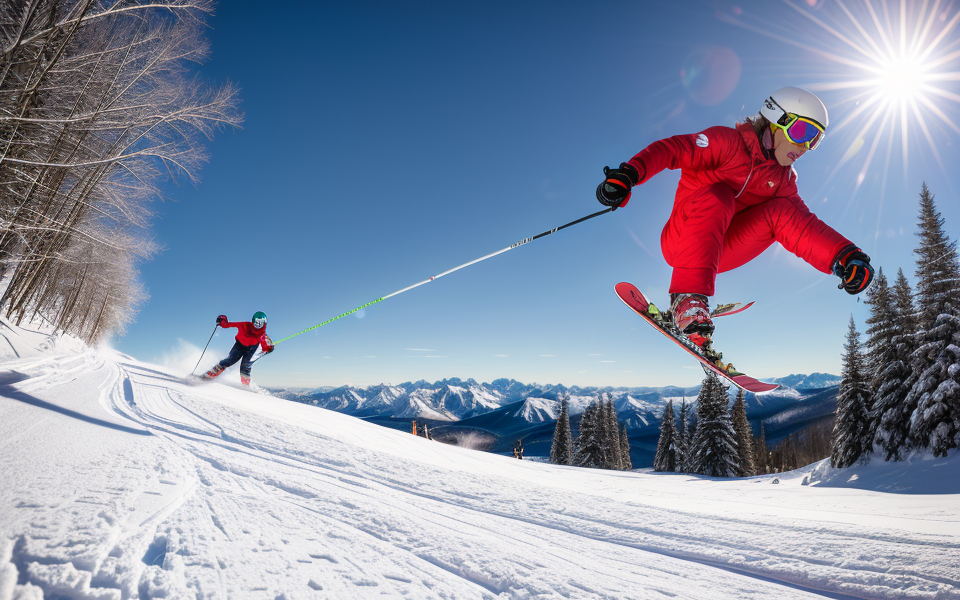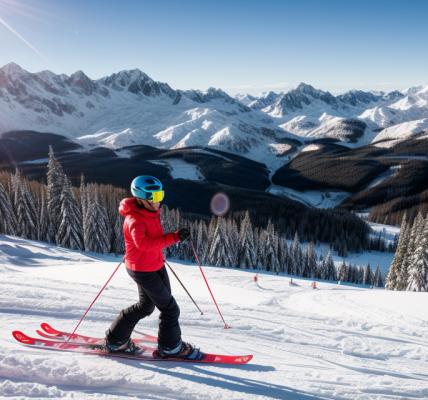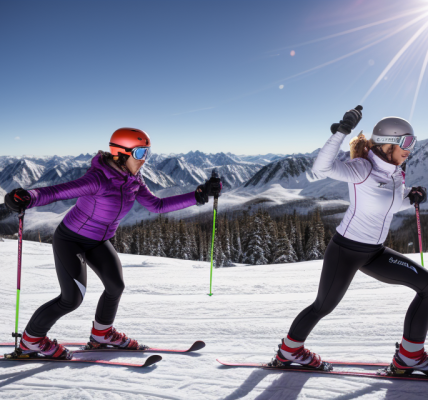What Makes an Advanced Beginner Skier and How to Develop Your Skiing Skills?
Are you someone who has recently started skiing and wants to take your skills to the next level? Or are you someone who has been skiing for a while but still struggles with some of the more advanced techniques? If you fall into either of these categories, then you may be wondering what it means to be an advanced beginner skier. In this article, we will explore the characteristics of an advanced beginner skier and provide tips on how to develop your skiing skills. So, whether you’re a new skier or a seasoned one, read on to find out how to take your skiing to the next level.
An advanced beginner skier is someone who has a solid foundation in the basics of skiing and is now looking to improve their skills and technique. To develop your skiing skills, it’s important to focus on building your stamina and endurance, as well as working on your form and technique. This can be done through regular practice and by taking lessons from a qualified instructor who can provide personalized feedback and guidance. Additionally, it’s important to challenge yourself and try new terrain and skiing conditions to continue to build your skills and confidence. Remember to always prioritize safety and to never ski beyond your ability level.
Understanding the Advanced Beginner Skier Level
Skiing Skills and Abilities of an Advanced Beginner Skier
An advanced beginner skier has developed a strong foundation in skiing fundamentals and is capable of navigating intermediate to advanced terrain. Here are some of the key skiing skills and abilities that define an advanced beginner skier:
- Skiing on intermediate to advanced terrain: At this level, an advanced beginner skier is comfortable skiing on a variety of terrain types, including groomed runs, moguls, and steeps. They have a good sense of how to control their speed and can make adjustments to their skiing based on the conditions of the snow and the terrain.
- Ability to link turns and ski with more control: Advanced beginner skiers have developed the ability to link turns smoothly and control their speed through a turn. They have a good understanding of how to use their edges and body position to initiate and exit turns, and can ski with more confidence and control on all types of terrain.
- Basic understanding of skiing fundamentals: Advanced beginner skiers have a basic understanding of skiing fundamentals, such as balance, pressure, and edge control. They have developed the ability to use these fundamentals to ski with more control and to make progress towards more advanced skiing techniques.
Overall, the skiing skills and abilities of an advanced beginner skier allow them to ski with more confidence and control on a variety of terrain types, and to continue developing their skiing skills towards more advanced levels.
The Transition from Intermediate to Advanced Beginner Skier
Skiing More Challenging Terrain
One of the key differences between an intermediate and advanced beginner skier is the ability to tackle more challenging terrain. Intermediate skiers may feel comfortable on blue runs, but advanced beginners can venture onto black runs and even attempt some green runs. This requires a higher level of skill and confidence, as well as the ability to adapt to changing conditions on the mountain.
Developing a Sense of Balance and Control
Another characteristic of an advanced beginner skier is a greater sense of balance and control. While intermediate skiers may still struggle with their balance, advanced beginners have developed a better sense of how to control their movements on the slopes. This allows them to make more dynamic turns and navigate more challenging terrain with ease.
Understanding and Implementing Basic Skiing Techniques
Finally, advanced beginners have a better understanding of basic skiing techniques and can execute them with more precision. This includes techniques such as edging, pivoting, and carving, which allow skiers to maintain control and make smooth, efficient turns. As a result, advanced beginners are able to ski more effectively and enjoyably, and are well on their way to becoming more advanced skiers.
Developing Your Skiing Skills as an Advanced Beginner
Improving Your Skiing Fundamentals
Body Position and Alignment
Proper body position and alignment are essential for an advanced beginner skier to maintain control and balance while skiing. This involves learning how to distribute your weight evenly over both skis and keeping your upper body facing downhill. To achieve this, it’s important to focus on the following:
- Posture: Keep your head up and look forward, with your shoulders relaxed and down. Avoid leaning too far back or forward, as this can disrupt your balance.
- Weight Distribution: Learn to shift your weight from one ski to another, based on the terrain and the type of turn you’re making. This will help you maintain balance and control while skiing.
- Hip Angle: Ensure that your hips are facing downhill, which will allow you to use your leg muscles more effectively and maintain balance.
Weight Distribution and Balance
Weight distribution and balance are critical for advanced beginner skiers, as they enable you to control your speed and maintain balance on different terrains. To improve your weight distribution and balance, focus on the following:
- Pole Plant: Use your poles to help you balance and control your speed. Plant your poles firmly in the snow when you need to slow down or stop.
- Edging: Learn to edge your skis to control your speed and direction. This involves leaning slightly into the turn and applying pressure to the inside edge of your ski.
- Body Shifting: Practice shifting your weight from one ski to another to maintain balance and control. This will help you make smoother turns and navigate different terrains.
Edge Control and Turn Shape
Edge control and turn shape are crucial for advanced beginner skiers who want to improve their overall skiing skills. To develop your edge control and turn shape, focus on the following:
- Edging Technique: Master the technique of edging your skis by applying pressure to the inside edge of your ski during turns. This will help you control your speed and direction.
- Body Movement: Learn to use your body to initiate turns and control your speed. This involves shifting your weight, using your poles, and moving your upper body to steer your skis.
- Turn Shape: Practice making different types of turns, such as round, square, and telemark turns. This will help you develop your skiing skills and learn to control your speed and direction on different terrains.
By focusing on these key areas, advanced beginner skiers can develop their skiing fundamentals and improve their overall skiing skills.
Expanding Your Skiing Abilities
As an advanced beginner skier, expanding your skiing abilities is crucial to improve your overall skiing skills. Here are some ways to help you achieve that:
Skiing Different Terrain and Snow Conditions
Skiing different terrain and snow conditions is an effective way to expand your skiing abilities. This involves exploring different slopes, trails, and ski resorts that offer a variety of skiing experiences. For instance, you can try skiing in powder, groomed runs, steeps, or trees. By experiencing different terrains and snow conditions, you can develop your skiing skills, build confidence, and learn how to adapt to different situations.
Developing Your Skiing Technique and Style
Developing your skiing technique and style is another way to expand your skiing abilities. This involves refining your skiing movements, improving your balance, and developing a smooth and efficient skiing style. You can work on your technique by practicing different skiing drills, such as mogul skiing, carving, and slalom. Additionally, you can also focus on developing your skiing style by incorporating various techniques, such as short turns, long turns, and jumping.
Experimenting with Different Ski Equipment
Experimenting with different ski equipment is another way to expand your skiing abilities. This involves trying out different ski models, bindings, and ski accessories to find the right equipment that suits your skiing style and preferences. For instance, you can try out different ski widths, lengths, and flex patterns to find the ideal ski for your skiing ability and skiing conditions. Additionally, you can also experiment with different ski accessories, such as ski goggles, helmets, and gloves, to enhance your skiing experience and comfort.
By expanding your skiing abilities, you can become a more versatile and skilled skier. It is important to remember that developing your skiing skills takes time, patience, and practice. Therefore, it is essential to stay committed, focused, and passionate about your skiing journey.
Practicing and Learning from Mistakes
Taking Lessons or Attending Ski Clinics
One of the most effective ways to improve your skiing skills as an advanced beginner is to take lessons or attend ski clinics. These sessions are typically led by experienced ski instructors who can provide personalized feedback and guidance on your technique. They can help you identify areas where you need improvement and provide specific exercises and drills to help you develop those skills. Additionally, taking lessons or attending ski clinics can also provide a supportive and non-judgmental environment where you can practice and learn from your mistakes without fear of criticism.
Video Analysis of Your Skiing Technique
Another effective way to learn from your mistakes as an advanced beginner skier is to record yourself skiing and analyze the footage. This can help you identify areas where you may be making common mistakes, such as leaning too far forward or backward, and allow you to make adjustments to your technique. Additionally, watching yourself on video can also help you develop a better understanding of your body position and movements, which can be useful in making improvements to your skiing technique.
Learning from More Experienced Skiers
Finally, learning from more experienced skiers can also be a valuable way to improve your skiing skills as an advanced beginner. Watching and observing more experienced skiers can provide insight into proper technique and help you identify areas where you can improve. Additionally, talking to more experienced skiers and asking for their advice can also be helpful in identifying areas where you may be struggling and provide guidance on how to improve. Overall, practicing and learning from mistakes is a crucial part of developing your skiing skills as an advanced beginner, and by taking advantage of the resources available to you, you can make significant improvements to your technique.
Advanced Beginner Skier Tips and Resources
Skiing Equipment for Advanced Beginners
As an advanced beginner skier, it is important to have the right equipment to enhance your skiing experience and improve your skills. The following are some essential pieces of equipment that you should consider investing in:
Choosing the right skis and bindings
One of the most important pieces of equipment for any skier is their skis and bindings. For advanced beginners, it is recommended to choose skis that are versatile and can handle a variety of terrain and conditions. Look for skis that are between 160-170cm in length and have a waist width of around 80-90mm. When it comes to bindings, look for ones that are compatible with your ski ability level and offer a good balance of comfort and performance.
Selecting appropriate clothing and accessories
In addition to your skis and bindings, the right clothing and accessories can make a big difference in your skiing experience. Make sure to wear layers that can be easily removed or added as needed, as well as moisture-wicking materials to keep you dry and comfortable. Consider investing in a helmet to protect your head, goggles to improve your visibility, and gloves to keep your hands warm and protected.
Using ski tools and accessories to improve your skiing experience
There are many ski tools and accessories available that can help improve your skiing experience, from tuning your skis to carrying your equipment. Consider investing in a ski tuning kit to keep your skis in top condition, as well as a ski carry bag or backpack to make transporting your equipment easier. Additionally, a ski waxing iron and wax can help improve your ski’s performance on different types of terrain.
Online Resources and Ski Communities
- Skiing blogs and websites
- These resources can provide a wealth of information on various aspects of skiing, such as equipment reviews, ski techniques, and trail recommendations. Some popular skiing blogs include The Ski Guru, The Ski Channel, and Skiing Life.
- Ski forums and social media groups
- Ski forums and social media groups can be great places to connect with other skiers, ask questions, and share tips and advice. Some popular ski forums include the Skiing Forum and the Ski and Snowboard Enthusiasts Group on Facebook.
- Skiing coaches and instructors for personalized advice and feedback
- Working with a skiing coach or instructor can be a great way to improve your skills and receive personalized feedback. Many ski resorts offer coaching and instruction services, and there are also online coaching options available. Some popular online ski coaching services include Skiveritas and Ski School Now.
Continuing Your Skiing Skills Development
Setting Skiing Goals and Tracking Progress
One of the most effective ways to continue developing your skiing skills is by setting specific goals for yourself and tracking your progress along the way. This not only helps you stay focused and motivated, but it also gives you a clear idea of what you need to work on in order to reach the next level of skiing. Some examples of skiing goals might include improving your overall technique, mastering a specific trick or maneuver, or skiing a particular trail or terrain.
To track your progress, you can keep a skiing log or journal where you record your practice sessions, lessons, and any notable achievements or breakthroughs. You can also take videos of yourself skiing and compare them to previous videos to see how far you’ve come. Additionally, seeking feedback from instructors, coaches, or more experienced skiers can help you identify areas where you need to improve and give you specific guidance on how to do so.
Staying Motivated and Inspired
Staying motivated and inspired is crucial for continued skiing skill development. While it can be challenging to maintain momentum and enthusiasm, there are several strategies you can use to stay motivated and engaged.
One effective way is to find a skiing buddy or group of friends who share your passion for the sport. Having someone to ski with regularly can help keep you accountable and provide a sense of camaraderie and support. You can also set up regular skiing challenges or competitions with your buddies to add an element of fun and friendly competition.
Another strategy is to set aside time for skiing that is completely separate from your work or other responsibilities. This can help you stay focused and energized when you’re on the slopes, and give you something to look forward to outside of your daily routine.
Preparing for the Next Level of Skiing
As you continue to develop your skiing skills, it’s important to start thinking about what comes next. This might mean setting your sights on more advanced terrain, seeking out additional instruction or coaching, or pursuing competitive skiing opportunities.
Whatever your goals may be, it’s important to prepare yourself both physically and mentally for the next level of skiing. This might involve additional physical training, such as strength and conditioning exercises, as well as mental preparation techniques like visualization and goal-setting.
It’s also important to be realistic about your goals and to take a gradual approach to advancing your skiing skills. Rushing into advanced terrain or skiing techniques without proper preparation can lead to injury or setbacks, so it’s important to progress at a pace that feels comfortable and sustainable for you.
FAQs
1. What is an advanced beginner skier?
An advanced beginner skier is someone who has already learned the basics of skiing, such as how to make turns, stop, and use the lifts, but still needs to improve their skills to move to the next level. They may be able to ski on green runs but are not yet comfortable on blue or black runs.
2. What makes an advanced beginner skier?
An advanced beginner skier typically has a good understanding of the fundamentals of skiing, such as balance, edge control, and body positioning. They are able to make turns on green runs and can control their speed and direction. However, they may still struggle with more challenging terrain, such as steeper slopes or icy conditions.
3. How can I develop my skiing skills as an advanced beginner?
To develop your skiing skills as an advanced beginner, it’s important to practice regularly and challenge yourself with more difficult terrain. You can take lessons with a professional ski instructor to improve your technique and get personalized feedback. It’s also helpful to ski with more experienced friends or join a ski club to gain more experience and support.
4. What equipment do I need as an advanced beginner skier?
As an advanced beginner skier, you will need a good quality ski suit, gloves, and helmet. You may also want to invest in a pair of ski goggles to protect your eyes from the wind and snow. It’s important to make sure your equipment is well-maintained and fits properly to ensure your safety and comfort on the slopes.
5. What are some tips for improving my skiing skills as an advanced beginner?
Here are some tips for improving your skiing skills as an advanced beginner:
* Practice your balance and edge control on flat terrain before moving to slopes.
* Start small and gradually work your way up to more challenging terrain.
* Take breaks and rest when you need to to avoid fatigue and injury.
* Stay focused and concentrate on your technique.
* Be patient with yourself and don’t get discouraged if you make mistakes. Remember that skiing is a skill that takes time and practice to master.




